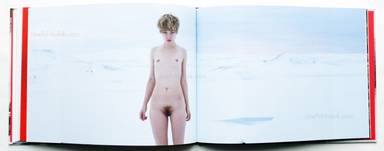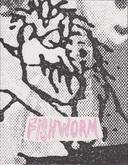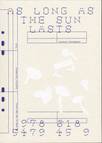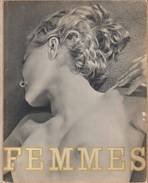Korbinian Vogt - Narrated Monologue, Self published, 2016, Munich

Korbinian Vogt - Narrated Monologue (Front)

Korbinian Vogt - Narrated Monologue (Spine)

Korbinian Vogt - Narrated Monologue (Back)

Sample page 1 for book " Korbinian Vogt – Narrated Monologue", josefchladek.com

Sample page 2 for book " Korbinian Vogt – Narrated Monologue", josefchladek.com

Sample page 3 for book " Korbinian Vogt – Narrated Monologue", josefchladek.com

Sample page 4 for book " Korbinian Vogt – Narrated Monologue", josefchladek.com

Sample page 5 for book " Korbinian Vogt – Narrated Monologue", josefchladek.com

Sample page 6 for book " Korbinian Vogt – Narrated Monologue", josefchladek.com

Sample page 7 for book " Korbinian Vogt – Narrated Monologue", josefchladek.com

Sample page 8 for book " Korbinian Vogt – Narrated Monologue", josefchladek.com

Sample page 9 for book " Korbinian Vogt – Narrated Monologue", josefchladek.com

Sample page 10 for book " Korbinian Vogt – Narrated Monologue", josefchladek.com

Sample page 11 for book " Korbinian Vogt – Narrated Monologue", josefchladek.com

Sample page 12 for book " Korbinian Vogt – Narrated Monologue", josefchladek.com

Sample page 13 for book " Korbinian Vogt – Narrated Monologue", josefchladek.com

Sample page 14 for book " Korbinian Vogt – Narrated Monologue", josefchladek.com

Sample page 15 for book " Korbinian Vogt – Narrated Monologue", josefchladek.com

Sample page 16 for book " Korbinian Vogt – Narrated Monologue", josefchladek.com
Other books tagged Landscape (see all)









Other books tagged German (see all)









Other books tagged Nude (see all)









Books to shop at anzenbergergallery-bookshop.com
Hardcover, signed. Design by Korbinian Vogt and Sebastian Lock, text by Olaf Unverzart.
What do we see, when we look at Korbinian’s pictures?
Beautiful, young women. Breathtaking landscapes. Silent portraits. Several things remain concealed at first – relationships, feelings and friendships. His interaction with himself. Memories become conditions, which shape these photographs along with his everyday existence. Korbinian is young, and has now reached a point at which he would like to use pictures to exercise control over his life. For which they are thankfully his central means and medium. That is a meaningful approach for him and at the same time lucky for us.
He needs these kinds of assignments. Days which he has to manage on his own. Girls in front of his camera in his room, or rather Greenland.The Alps, big European cities and repeatedly Iceland. It doesn’t correspond with his logic to say: “I’ve been there once already, I’ve already photographed that.” No, he is more than just impressed by it. His dreams cling to moments and places. The terrifying ones are so present that they provide another reason for holding on to the beautiful ones all the more tightly. He regularly works with the same models repeatedly.
People who have long since become his friends. People who have real names. They travel together, go out, experience surprises, simply feel young together. Korbinian’s pictures, however, do not aspire to be modern or hip. The point in time that they are taken doesn’t play a crucial role. The late 1980’s are more apparent than the Instagram aesthetic of his generation. His photographs don’t look like backlit juveniles on road trips with cigarettes in their mouths. He doesn’t have a driver’s license and doesn’t smoke. He is just as unimpressed by nude photography, as practiced by amateurs. Much rather, we see women in his pictures, who pose as Korbinian would like, and yet don’t look posed at all. In this way they radiate trust and self-confidence. They appear to really be interested in the camera, and in him. One could say that these are actually more like
get-togethers than photo shoots. The models do not have to act what they are.
Nude art has to be naked. It comes across to us as art, because Korbinian manages to win his protagonists over. They are both important and beautiful - and that’s exactly what he imparts to them. Korbinian’s world has already, in his young life, become difficult to get an overview of to a certain extent. Opportunities don’t need any approval anymore. Everything is up to him. The wide world is accessible yet remains the same, full of precipices. He often gives the impression of being like a priest, fallen from another age. Reserved, well-behaved, dreamy. But also like an artist,
sleepy-eyed and enthused by ideas – who is far away from where he is standing.
With his photography, he tries to order circumstances. Through creative possibilities he experiences the power and the joy that each one of us needs every day in order to create something. He wants to see landscapes as being beautiful. He searches long for and in them, to find the thing that turns the captured images into his sanctuary and projection. The female body plays a central role in this, between icebergs and Northern lights. It’s not without reason that Korbinian’s own favorite picture shows exactly this constellation. A young woman, eyes averted, standing in a beautiful but inhospitable landscape (page 36), free of clothing and any kind of coding. Free of utility or any answer to the question of what is actually going on here. You don’t learn table manners only on the internet. But you can, too. Korbinian can eat a lot and sleep long hours. Sometimes he forgets both. And goes for a walk. Until the circle closes and he starts all over again, to find out if anything has changed. He often asks the same question repeatedly, but is less keen to listen to the answer. Korbinian’s world fills me with fear and joy at the same time.
That’s also exactly what characterizes his photographs. They brace themselves against being lost and thus open up a visual level replete with little miracles. His miracles – between soliloquy and storytelling.
Pages: 80
Place: Munich
Year: 2016
Publisher: Self published
Size: 26 x 20 cm (approx.)




















